James, one of our Long-Haul Specialists, is just back from the Azores. Here are some of his highlights!
So when I was given to the opportunity to go to the Azores, which is often considered an alternative to Iceland, to see different landscapes and learn about the formation of these remote islands in the Atlantic Ocean, I was excited and a little nervous as to what to expect.
The Azores, an autonomous region of Portugal, are an archipelago in the mid-Atlantic.
The islands are characterised by dramatic landscapes, fishing villages, green pastures and hedgerows of blue hydrangeas.
São Miguel, the largest, is home to lake-filled calderas and the only tea plantation in Europe! This was where I was heading as we had two groups due to travel there and it was an excellent opportunity to see how the students and staff engaged with the island through their studies.
Here are some of my highlights:
Whale and dolphin watching
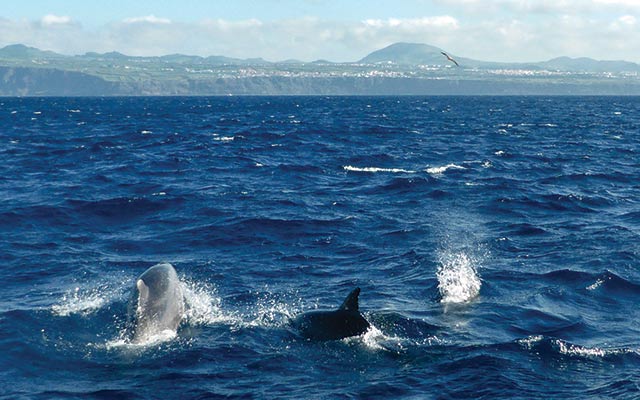
We boarded the catamaran and were given a safety briefing before leaving harbour.
Heading out into the open ocean you can’t help but think how those early pioneers felt as they too left the safety of the port and headed into the Atlantic Ocean.
It wasn’t long before we had our first sighting as we approached a pod of bottlenose dolphins feeding a few kilometres offshore.
With a mix of young and old, they lived up to their playful reputation as they swam around the boat and rode the waves.
We watched them skilfully drive fish to the surface where a myriad of sea birds took advantage of the abundant food to grab a meal for themselves.
And a little while later we also encountered a pod of common dolphins, again feeding in the rich waters around the islands.
Caldeira Velhas and the geothermal power plant

We made a brief visit to a geothermal power plant to learn about how the Azores is beginning to utilise its geothermal resources to provide power for the island, before driving the short distance to the geothermal pools and waterfalls at Caldeira Velhas.
Here, the thermally heated stream has been managed to create a series of small bathing pools along its course.
Each of these pools have slightly different properties and temperatures, because the water cools as it flows down from the upper pool.
A series of pipes and drains help to regulate the the flow and maintain the pools through the day. They are switched off in the evening as the park closes, to allow the river to flow naturally.
There have been bathing pools here for many years and an interpretive centre tells the story of the area.
Lagoa do Fogo
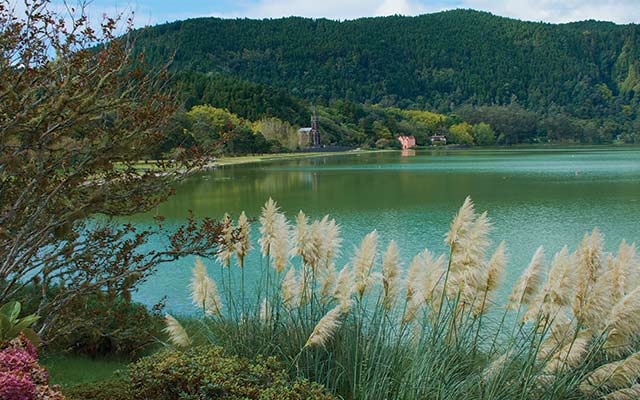
Our final trip of the day takes us back to the main town via the viewpoint overlooking the impressive crater lake of Lagoa do Fogo, so named by the early settlers for the molten lava that glowed and reflected on the surface at night, lighting up the area with a eerie glow.
Today the volcano lies dormant and has rich vegetation within it, creating a habitat for many birds who nest in the steep crater walls.
The volcanoes of São Miguel all lie dormant and have done for many years, allowing a lush green landscape of native and introduced species to thrive on its fertile soils.
From the viewpoint above the lakes this green landscape can be seen, from coast to coast – that’s if you manage to see it through the cloud and mist that forms on the rising flanks of the volcanoes as the moist Atlantic winds hit the warming land!
Furnas
Furnas is the second largest of the crater lakes on São Miguel and lies in the east of the island.
The road into the centre of the crater passes through a gap in the crater wall and winds round the lake to reach a small activity centre and geothermal field, where small mounds of earth look like miniature volcanoes sprouting from the warm earth.
The reality is somewhat less dramatic, but no less intriguing.
It turns out that these mini volcanoes are created each day by the locals who utilise the geothermal ground heat to cook the local specialty of cozido, a stew cooked in the ground for six hours, before being removed and delivered to the local restaurants.
A walk around the lake on well-maintained pathways takes around 90 minutes. As you pass through the woodlands around the crater (created to stabilise the ground and provide oxygen for the area, as well as remove harmful carbon and other minerals) you begin to appreciate the scale of the crater.
The locals have harnessed the power of the Earth here, but also realised its fragility. Careful land use management is helping to maintain this amazing landscape.
Canoeing on a crater lake

Once around the lake there is an opportunity to see the crater from a different perspective - from the lake itself.
A canoe ride on the lake allows you to see the scale of the area from the water.
The lake is calm, but deceptive winds that circulate in the crater make the experience more exhilarating as your paddling skills are tested.
The effort and energy are more than rewarded by the amazing views as you gaze at the caldera from the lake.
On dry land once more we headed into Terra Nostra to sample the famous cozido. It wasn’t quite what everyone had expected, but it’s a great, authentic experience and the food is so tender and flavoursome, having been cooked by the natural heat of the Earth.
Spectacular botanical gardens

The most impressive botanical garden in the Azores is just around the corner from the hotel where we enjoyed our cozido lunch.
Here, over 1000 species of native and introduced species thrive in beautifully maintained gardens.
From Japanese Azaleas to New Zealand ferns and Australian figs growing alongside native species, the gardens radiate out from a central thermal pool. Smaller pools at different temperatures complement the main pool.
Lush tea plantations
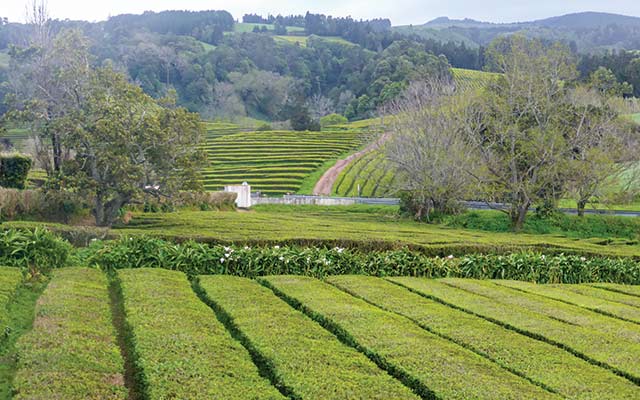
We also had the opportunity to visit a truly unique business in Europe – a tea plantation!
Tea was introduced to the Azores by traders travelling between Asia and Europe. There are two plantations on the island producing tea that’s exported all over the world, particularly North America and Canada.
A lot of migrants from the Azores settled in North America and their descendants retain the tastes of these early settlers, including their taste in tea!
Indeed, most people in the Azores can claim to have relatives living in North America to this day.
The plantation has a small museum/display area detailing the tea-making process, which is well worth a visit – and the tea makes for a nice alternative souvenir for friends and family.
Pineapples
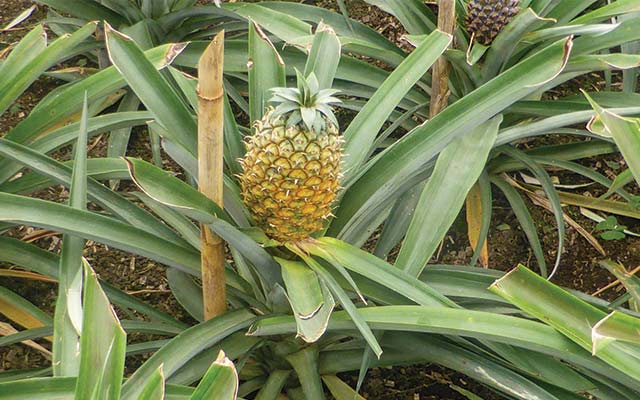
We also spent some time learning about another Azorean peculiarity - pineapples.
Pineapples are grown on the island under glass due to the climate and, unlike their tropical cousins, take around 2 years to grow.
This labour-intensive production method means the fruit is more expensive and less sweet, however they are still a major economic commodity of the islands.
We saw how the plants are produced through the various stages of growth, right to the picking of the mature fruit.
There’s a small shop on site selling all the pineapple-based products…but not the pineapples themselves! These are sent to local suppliers to be sold at market and for export. They do, however sell a very nice (very alcoholic!) liqueur.
Sete Cidades craters and lakes

Souvenirs purchased, we headed west to the youngest part of the island, formed following the eruptions of Sete Cidades and other local volcanoes which last erupted around 1500 years ago.
The area is very green, much like the rest of the island, but the flanks of the volcanoes still show the bare, exposed rocks from the last flows.
The predominant rock type here is basalt and the exposed layers of rock show the flows and formations quite clearly.
We arrived at the most popular tourist spot on the island, Boco do Inferno viewpoint, overlooking the Sete Cidades crater and lakes.
The name refers to the seven smaller volcanic cones that sit in the main caldera. This is the largest caldera on the island and the most popular among tourists.
The road winds around the rim of the crater, drops over the edge and meanders down to the floor of the crater.
Here, two lakes, separated by the road bridge, dominate the crater floor - the larger Blue Lake and the smaller Green Lake.
Local legend has it that they were formed from the tears of two separated sweethearts - the green-eyed boy’s tears forming the Green Lake and those from his blue-eyed belle forming the Blue Lake. Science tells us differently but, of course, the folklore is more romantic.
Authentic Azorean hospitality
We enjoyed a lunch at Quinta da Queiro, a converted barn run by a farming family who have lived locally for several generations. This is the highlight of the week for many groups as they get to experience authentic Azorean hospitality.
The food is plentiful, tasty and beautifully prepared. No one wants to leave after visiting the small menagerie they have on the property, with goats, rabbits and chickens providing a little post-lunch entertainment.
Spectacular views of the Azorean sunset
Another popular stop in the west, especially as the sun sets, is the Ponta do Escalvado viewpoint, as it offers clear views over the water.
Not only that but here also there are some excellent old lava flows forming cliffs which, because of their inaccessibility, provide nesting sites for the local sea birds.
With the abundant waters providing plentiful food, it’s a great place for them to raise their chicks in relative safety.
Mosteiros can be seen from here. This is another popular fishing village that has seen the tourist numbers increase as they arrive to see the setting sun from the local beach and take photos of the imposing sea stacks in the bay.
Gruta do Carvão
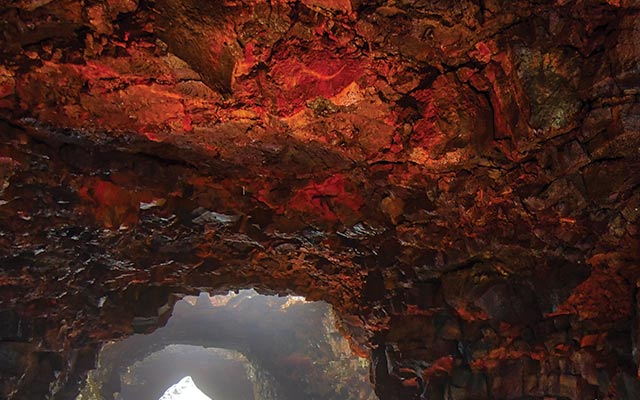
Our final stop of the day is Gruta do Carvão, an ancient lava tube on the outskirts of São Miguel.
With the longest tube over 1600m long, and possibly even as long as 3km, these are among the most spectacular examples of this landscape in Europe.
Plus, this is only the bit they’ve been able to explore so far - research suggests there is much more yet to be investigated! Such is the importance of this system that in 2005 it was designated a Regional Natural Monument.
The caves themselves have examples of lava bridges, branching galleries, lava balls, stalactites, stalagmites, columns, spongy lavas, glaze and tree moulds.
Apart from several cracks, the walls and ceiling are multi-coloured (orange to yellowish) due to the basalt oxidization.
There are also secondary mineral deposits of silica and earthen deposits covering the walls and ceiling.
The caves are kept at a constant temperature and humidity to protect these features and, although only a brief visit, it is stunning to see. Longer tours are available which go deeper into the system and require a little more experience.
From the surface it is difficult to imagine the features below ground, the only signs being the restricted land usage above discovered areas which further assists in their preservation.
Fantastic accommodation for school groups
I also wanted to see other aspects of life in the Azores, so I met up with Ruben, a member of the team from our ground suppliers in the Azores.
We visited the Vila Nova Hotel and the Ponta Delgado Youth Hostel. Both of these properties are well situated and ideal for groups. In fact, the youth hostel is a converted convent that is now a very popular base for many.
Experiencing the local agriculture
Travelling through the green meadows of the Azores, the islands’ main inhabitants graze contentedly in the early morning sunshine.
With two cows for every person in the islands the dairy industry is one of the key contributors to the economy of the Azores. The production of cheese, yoghurt and, of course, milk, is a key industry, with each island having its own speciality.
The island of São Jorge is renowned for producing some of the best cheese of the region. No meal in the Azores is complete without sampling some of the local cheese!
Later, we set out to meet a local farmer at Quinta das Raiadas for a dairy experience.
This is something that groups can experience and allows them to get up close and personal with the islands’ main inhabitants - namely cows, as well as goats, chickens and bees.
For groups there are various activities that can be done. My first was milking a cow...by hand.
I’m a country boy and this took me right back to my time on the farm as a youngster, following my dad around and trying my best to avoid the mad farm cats surrounding the milking parlour!
Groups can get more involved with the day-to-day activities such as feeding, milking and collecting eggs. This is ‘getting your hands dirty’ work and is highly rewarding.
We then transferred to a small clearing in the woods, near the farm. Here I politely declined the opportunity to inspect the bee hives that produce some of the local honey.
Everything here has a purpose to it - the people have learned to live in harmony with nature and benefit from its bounty, whilst preserving the natural order of things.
The Azores produce many local specialities and have used the unique ecosystems on each island to do so.
The final stop is the best one, where we get to sample many of these local products – cheese, honey, fruit, juices, bread and liqueur.
Final thoughts?
My brief stay here has been fun, informative and interesting.
A last look over the island as the plane takes off makes me want to return and see more of these amazing islands. I love Iceland, but I have fallen in love with the Azores.
Interested in arranging a geography trip to the Azores?
Then please don’t hesitate to contact us for further information and advice.